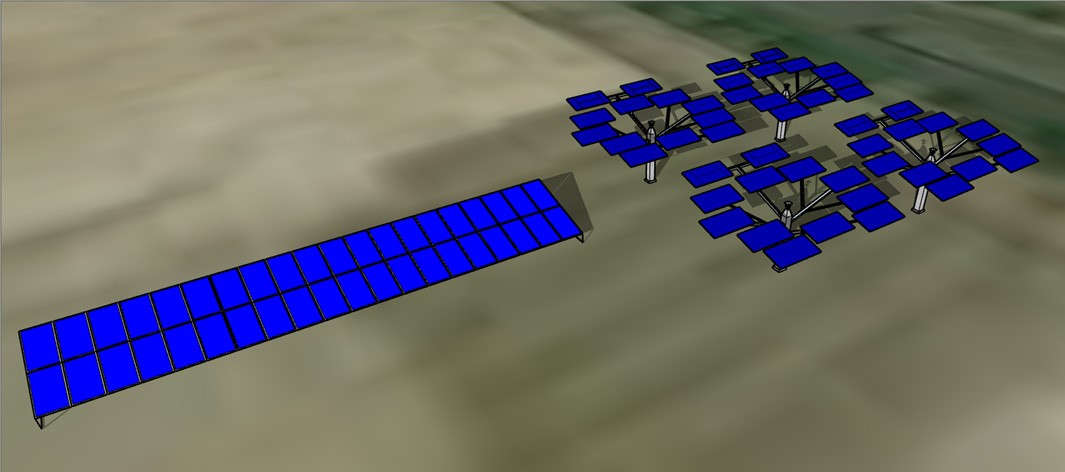Researchers from Amity University, Noida, in the Indian state of Uttar Pradesh, have developed four different designs for solar photovoltaic trees that purportedly require less physical space than conventional PV systems in urban environments.
“We are currently in the process of installing a prototype at Amity University campus in order to study practical applications of the concept described in the paper,” researcher Abhishek Verma told pv magazine. “Our proposed novel designs can definitely be used in practical ground applications. We tried to create a balance between aesthetics, energy generation, and technology.”
The scientists describe the system as a solution for on-grid and off-grid applications where space availability is a major constraint and shading effects should be avoided. The performance of the four designs, each with an installed power of 20kW, was measured and compared to that of conventional ground-mounted PV systems. The scientists used a series of simulations with the campus of Amity University set as a location, with solar irradiance of 1,737.4 kWh/m²/year.
The four systems – Tulip Tree, Sunflower Tree, Marigold Tree, and Daisy Tree – were named according to their different shapes. It was assumed that they would be deployed with 380W monocrystalline modules installed at a tilt angle of 20 degrees.
The Tulip Tree relies on a main support pole structure, with two branches that can each accommodate six modules. The foundation of the model takes up 4 square meters of space and the ground clearance from the lowest edge of the panels is approximately 4 meters. Five trees of this kind can be combined into a 22.8kW installation.
The Sunflower model is built with only one support structure, tilted 20 degrees, with up to 10 380W modules, to reach a total capacity of 3.8kW. Six trees can be combined together to reach a capacity of 22.8kW.
“This model can be utilized in public recreational areas in cities like parks, playgrounds, stadiums, and car parking,” the scientists explained, noting that land area occupation and clearance are the same as the Tulip design.
The Marigold model consists of a single support structure with branches inspired by the branches of real–life trees. This tree configuration can host up to 15 380W modules and reach a total power of 5.7kW. The land area occupied by the foundation of this model is 5.76 m2 and ground clearance is 4 meters.
Popular content
In the Daisy system, the solar modules are arranged in landscape orientation, to optimize DC cable quantity, and a single support structure hosts up to 15 panels with a power output of 380W and a total capacity of 5.7kW. This configuration has the smallest occupation area at 3.3 m2 and a clearance of approximately 4 m. Four Daisy Trees can be combined to reach 22kW.
“One major advantage of this tree design is that we can easily integrate a double axis tracker system in the structure, to further increase the energy generation, if required,” the Indian group said.
Through the simulation, the Tulip model was found to have a land consumption ratio (LCR) of 0.083530 and a power-to-land occupancy ratio (PLR) of 0.91, while the Sunflower type had an LCR of 0.08 and a PLR of 0.95. The Marigold tree achieved an LCR of 0.077 and a PLR of 0.99. The Daisy design had the lowest LCR at 0.04 and the highest PLR at 1.7. The reference conventional ground-mounted plant reached an LCR of 1.0 and a PLR of 0.076.
“The percentage saving of land procurement cost in case of Tulip Tree, Sunflower Tree, Marigold Tree and Daisy Tree are 84.57%, 85.14%, 85.70% and 91.46%, respectively, as compared to land cost in a conventional ground-mounted SPV plant, promoting dual usage of land,” the scientists said.
Verma estimates the cost of the trees at $4,500 to $5,500 for a 5kW system, excluding the price of land. “However, the cost analysis depends on many variable factors and company to customer requirements,” he concluded.
The scientists described the solar tree design in “Solar Photovoltaic Tree: Urban PV power plants to increase power to land occupancy ratio,” which was recently published in Renewable Energy.
This content is protected by copyright and may not be reused. If you want to cooperate with us and would like to reuse some of our content, please contact: editors@pv-magazine.com.



[ sso.rajasthan.gov.in] Raj SSO ID Registration | Rajasthan Single Sign On | राजस्थान एसएसओ आईडी SSO ID
This is the best article very nice bro
Very good information, I hope you keep writing such articles.
Superb idea. Write more articles on this topic.
Amazing idea and really loved the article
Very good information, I hope you keep writing such articles. Thanks PV
Wow great idea. Thanks for sharing this method.
Superb idea. Write more articles on this topic.